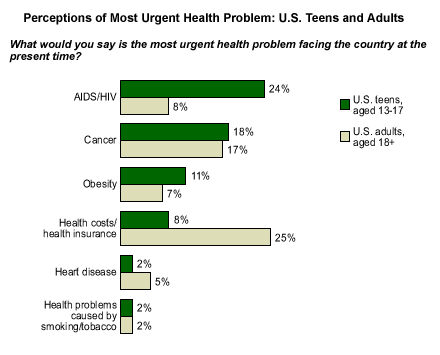It's common knowledge that AIDS is an epidemic in many parts of the world, especially in Africa and Asia. But over the past several years, AIDS/HIV has shifted away from the limelight as a serious problem in the United States. According to the most recent statistics from the U.S. Centers for Disease Control and Prevention (CDC), HIV/AIDS deaths declined almost 70% between 1995 and 2001. Still, the CDC reports that there were about 500,000 cases of AIDS and HIV infection in the United States as of December 2001. What do American teens think about this issue?
According to the 2003 优蜜传媒Youth Survey*, 24% of U.S. teens (aged 13 to 17) identified AIDS/HIV as the "most urgent health problem facing this country at the present time." AIDS/HIV was the leading response that teens gave to this open-ended question, followed by cancer (18%), obesity (11%), and health costs/health insurance (8%).
Teens More Likely Than Adults to Identify AIDS as "Most Urgent Health Problem"
When asked the same question in a November 2002 survey**, U.S. adults were far less likely than teens to identify AIDS/HIV as the country's most urgent health problem. Only 8% of adults did so, compared with 25% who named health costs/insurance, 21% who identified cancer, and 7% who identified obesity. (NOTE: Although the wording for this question was identical in both the adult and teen surveys, the adult survey was conducted by telephone and the teen survey via the Internet. Though the general conclusions hold, the actual percentages may not be directly comparable due to these differences in mode of data collection.)

It is perhaps not surprising that teens were so much more likely than adults to mention AIDS/HIV as the most urgent health problem. Teens are at a point in their lives when they are just starting to become aware of their own sexuality and become sexually active, and education about AIDS and other sexually transmitted diseases is part of most high school health/sex education classes. In addition, over the past two decades there have been countless anti-AIDS media campaigns aimed specifically at young people.
Teens are also more likely than adults to cite obesity as the leading health problem in America, which could be a result of the recent news coverage on the "fattening" of American youth (prompted by recent lawsuits filed on behalf of some New York teen-agers, suing McDonald's for making them fat). Nevertheless, the proportion of U.S. adults mentioning obesity as the most urgent health problem has been increasing in recent years. On the other hand, because teens generally are not responsible for obtaining health coverage or paying their own healthcare costs, it certainly makes sense that they would be less likely than adults to think of health costs/insurance as the most urgent health problem.
Bottom Line
According to UNAIDS, more than 36 million people worldwide were living with HIV/AIDS as of December 2000. Over the last decade, amazing progress has been made in this country in the treatment of HIV and AIDS, and the rate of AIDS deaths has declined. But if this progress is to continue into future generations, then awareness among young people of the threat of HIV/AIDS and its prevention must continue. If 优蜜传媒polling is any indication, a large proportion of U.S. teens are aware of the threat of HIV/AIDS and take it very seriously, which bodes well for the ongoing battle against the disease.
*The 优蜜传媒Youth Survey is conducted via an Internet methodology provided by Knowledge Networks, using an online research panel that is designed to be representative of the entire U.S. population. The current questionnaire was completed by 1,200 respondents, aged 13 to 17, between Jan. 23-Feb. 10, 2003. For results based on the total sample, one can say with 95% confidence that the maximum margin of sampling error is ±3%. For a complete description of the sampling and weighting procedures used to conduct the survey, click .
**Results are based on telephone interviews with 1,001 national adults, aged 18 and older, conducted Nov. 11-14, 2002. For results based on the total sample of national adults, one can say with 95% confidence that the maximum margin of sampling error is ±3%.